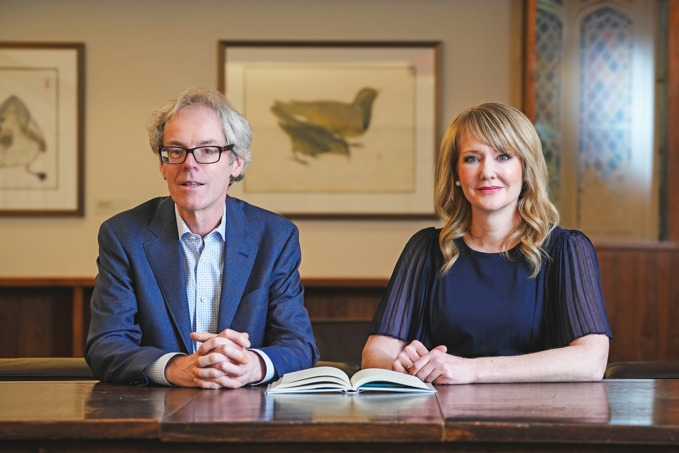In a business world captivated by tech unicorns and disruptive upstarts, Resurgent: How established companies can fight back and thrive in an age of digital transformation offers a timely counterpoint. Co-authored by Julian Birkinshaw, Dean of Ivey Business School, and John Fallon, former CEO of Pearson and a seasoned leader in education and digital transformation, the book argues that legacy companies aren’t destined for obsolescence. They, in fact, can thrive in the digital age by embracing change on their own terms.
Designed as a practical handbook for leaders navigating disruption, Birkinshaw and Fallon draw on decades of leadership and academic experience to explore how established firms can tap into their enduring strengths, including deep customer knowledge and operational expertise – while shedding outdated practices and mindsets. The spark for the book came from the intersection of their professional journeys: Birkinshaw’s research into corporate response to technological disruption and Fallon’s firsthand experience leading a multinational publishing firm through digital upheaval. What began as an executive education course evolved into a strategic playbook for leaders navigating complexity and disruption.
Resurgent is available in print in Europe starting July 17 and in North America beginning October 21. The Kindle edition will be available globally via Amazon starting July 17.
In advance of the launch, Ivey Impact sat down with Julian Birkinshaw to discuss the big themes and findings from Resurgent.
1) Resurgent challenges the idea that startups and big-tech (Alphabet, Amazon, Apple, Meta, Microsoft etc.) are inherently more innovative than legacy firms. Why do you think this myth has endured for so long, and what does your book suggest we might be missing when disruption is glorified over adaptation?
Some narratives are inherently more compelling than others. The story of the upstart vanquishing the incumbent is interesting. The story of the incumbent gradually evolving is not. So, it’s hardly a surprise that the start-ups and big tech companies get all the attention. They are – to be fair – more likely to do innovative things than big established companies. But, the big argument here is that there are many routes to enduring success, even if some of them are a bit more pedestrian than others.
2) The book talks about the importance of taking a “fast second” strategy rather than rushing to be a first mover. What are some risks companies face when they adopt emerging technologies too early—and how can leaders tell when the time is right to act?
There are plenty of cautionary tales of established companies jumping into new technologies too early – General Motors EV1 (an early electric car), British Petroleum’s push into renewables in the early 2000s, Time Warner buying AOL, GE’s failed digital division, and so on. The risk is primarily financial – the Time Warner/AOL deal was perhaps the most extreme, with a $54 billion write-down in 2002. But there are reputational risks if you back the wrong technology, and of course there is a risk of being distracted from your core business.
It’s really difficult to give practical advice on when the right time to act is, because it’s so context specific. But here are two useful points. “Fast second” doesn’t mean ignoring the new technology – it means working with it in a limited way, with perhaps a small team and a few small acquisitions, to build your expertise and your absorptive capacity. The other point is to focus on where the technology will affect your business. As we explain in the book, so-called demand side effects (which change how your customers behave) are more volatile and risky than supply-side effects. Understanding previous patterns of technology evolution can be very helpful in figuring out when to move forward yourself.
3) Digital transformation is often portrayed as a purely technical challenge, but you make a case for seeing it as an organizational and cultural one. In your experience, what part of the transformation journey tends to be most overlooked or misunderstood?
I think my coauthor John Fallon’s stories about Pearson are very instructive. He describes how tough it was for the tens of thousands of Pearson employees to get their heads around the transformation journey, because it seemed never-ending. “Are we there yet?” was a common refrain. John’s learning from that experience was that the leader’s job is to absorb the huge level of uncertainty about the future and to break down the change journey into steps that there was some predictability about. Or, to say it slightly differently, the biggest organizational challenge is dealing with not having control over the timing of change.
4) You say the most successful incumbents are the ones that develop an eye for disruption when developing new digital products and services. What does this mean, and does it come with risks?
It is healthy for leaders to develop a certain level of ‘paranoia’ over the possibility that their business is going to be disrupted by whatever new technology is coming down the track. But, they should balance it with a pragmatic understanding that they will probably be just fine. We provide a number of tips and exercises, to help you imagine new products and services that could potentially destroy your business. At very least, this is a way to forewarn you about what a start-up competitor might do; and it could even be something you want to invest in yourself.
5) You urge leaders to “learn, don’t guess” and to embrace experimentation, even at the risk of small failures. Yet many leaders remain uncomfortable with trial-and-error approaches. What cultural shifts need to occur inside organizations to support this mindset?
Yes, it’s a curious fact that leaders are consistently advised to conduct small-scale experiments, but they still prefer to do the analysis and then go all-in with whatever decision they make. I have been advocating greater tolerance of well-intentioned failure for a long time, and I have developed various techniques to help. (See my article in HBR, "Increase Your Return on Failure", 2016). But, it takes a long time to shift a culture in the necessary way here.
6) One of the metaphors used is ‘fixing the engine while flying the plane’ to describe the challenge of transforming legacy operations without breaking them. How can companies manage this kind of ‘ambidextrous’ innovation without exhausting their people or losing focus?
Some companies try to keep these two spheres of activity apart – in financial services for example, you often have separate ‘run the bank’ and ‘change the bank’ software development teams. This can work, but my more general advice is to try to get everyone thinking in terms of the dual responsibility they have of flying the plane and also fixing the engine. The people who best understand how the market is changing are those closest to the front line, and it is energizing for them to have the opportunity to influence the future development of their organization. Of course, this is harder work than just simply ‘doing your job,’ but the majority of people – in my experience – respond well to such opportunities.
7) The idea that ‘incumbents will almost always find a way’ runs counter to the cautionary tales of Kodak or Blockbuster. What lessons should we really be drawing from those high-profile failures, and how might they differ from the actual odds most legacy firms face?
Yes, there are famous cases of big companies that went bankrupt. But, the key point is that they are very few in number, and usually they faced very specific and extreme circumstances. Kodak, for example, was hit by a double whammy – a supply side disruption (digital, not film-based, imaging) and a demand side disruption (people sharing images on Instagram rather than printing them off). It’s important to study these cases, and to understand the confluence of factors that led to failure. As another example, Toys “R” Us failed not just because it was slow to address the online revolution but because it was also financially leveraged. The point here being that if you are facing a really uncertain future, make sure you have a good financial cushion to weather the storm.
8) With generative AI now taking centre stage in the tech conversation, how can incumbent firms apply the lessons of Resurgent to avoid either overreacting to the hype or falling behind in adoption?
The first point is to not fall for the hype – the impact of gen AI over the long term may indeed be huge, but for the vast majority of companies its disruptive effect will be surprisingly small in the near term. There are a few specific sectors that are in deep trouble – companies offering translation services for example – but most will end up seeing gen AI as a ‘sustaining technology,’ not a disruptive one, that helps them go stronger. I actually wrote an article on this precise question called “Will AI Disrupt Your Business?” that comes out in Sloan Management Review this summer.









